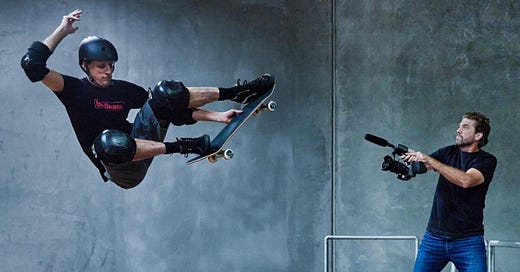Tony Hawk: Until the Wheels Fall Off
The skateboarding legend is revealed in all his complexity, doubts and foibles in this illuminating documentary that pierces the mythology.
I pride myself on loving virtually any iteration of cinema, from cheesy romcoms to gruesome horror flicks and everything in between. But I admit there are three film topics that instantly make my eyes glaze over: surfing, martial arts and skateboarding.
Maybe it’s because I consider them such inconsequential endeavors. Or maybe because they require highly developed balance and grace, things I personally lack in abundance. Be that as it may, I find entire movies revolving around these quasi-sports hard to get through.
So I was pleasantly surprised by “Tony Hawk: Until the Wheels Fall Off,” the new HBO documentary from Sam Jones that looks at the life and career of the skateboarding legend, who’s universally regarded as the Michael Jordan of boarding.
I mostly know Jones from his terrific “Off Camera” series interviewing big-name actors and other industry folks, in which he gets them to talk about their craft in illuminating ways and reveal things you’ve never heard before.
He uses much of that same technique with “Tony Hawk,” getting not only the subject to speak openly and honestly and about his hopes, doubts and foibles, but also dozens of important people who figure into his life or skateboarding, from friends to former competitors.
A central theme of the doc is why Hawk, at age 53 and with a host of mounting injuries from decades of flinging his body this way and that in open contempt of gravity, continues to skate. Many people would like him to stop.
To underscore this sense of tragedy, early on the filmmakers show Hawk trying again and again to land a particularly challenging trick, one that eluded him even when he was in his prime.
As we watch him fall to the ground again and again, sometimes cursing, sometimes needing several minutes to rise again, we wonder why he does so. What compels a man to batter his body and brain so, especially now that he is already rich and famous? What reward could such abuse possibly hold?
But over the next two hours, Jones and his interview subjects show us.
Hawk grew up a ridiculously skinny California kid who wasn’t good at sports or anything in particular. But the first time he got onto a skateboard, he just knew. Helped by a father who was a retired Navy man and had plenty of time on his hands, he began skating everywhere he could, entering amateur competitions and learning every trick he could — and inventing a few of his own.
He eventually fell in with the Bones Brigade, a group of strutting showmen led by Stacy Peralta, one of the pioneers of skating who eventually became more interested in filming and promoting it. Peralta was not exactly a second father figure to Hawk, but certainly a mentor and someone who helped push him.
Hawk was earning tens of thousands of dollars on weekends while still in high school in the 1980s. And of course, he lived and spent unwisely, because what else would anyone do in that circumstance? When the bottom fell out of skating around 1990, he found himself married with a baby and unable to support himself. Hawk’s wife, a manicurist, became the family breadwinner for a time.
But skating is cyclical, and by the late 1990s it came back bigger than ever. Hawk had his own traveling show, a skateboard line, a video game series that netted him millions, and virtually everything one could ask for.
But as his crowd got older and began to drop away from the sport, Hawk continued to push himself. Jones takes us inside the mind of a guy who was so singularly committed to one thing, it crowded out everything else in his life. He just had to land that next new trick, push over the next horizon.
His white whale was “the 900” — 2½ complete revolutions in the air while hovering above the lip of the rink. It was the next evolution of the “McTwist,” aka 520s, which was the big thing when Tony was rising up. He was committed to land one, and would literally keep trying until he broke bones. Then he’d heal up, get back on the board and try again.
Interestingly, Hawk was dismissed by many of the skateboarding pros when he was starting out, who favored big displays of athleticism and showmanship. Hawk made up for his physical weakness with deft tricks and complex, innovative moves — “baton twirling,” as one gruff adversary dubbs it — that eventually won over the judges and fans.
Another figure that emerges in the story is Rodney Mullen, a contemporary of Hawk’s who wandered away from the competitive side at an early age and became immersed in the artistic ballet of it, now known as freestyling. He’s like the wise old man of skating who understands why people like Hawk and he can never get off the board until they’re physically unable to.
“We skate with our hearts,” he says, and if that sounds a little overwrought when it comes out of his mouth, by the end of this wonderful documentary we’ll understand how much he means it.
I’ve often said the best sign of a good documentary is that it can take you into a community that may seem strange or even ridiculous to us at first, but by the end we feel in our hearts why these people do the things they do. I’m still not ready to climb on a board and try some McTwists, but I finally saw a skateboarding movie that had me completely gripped.





